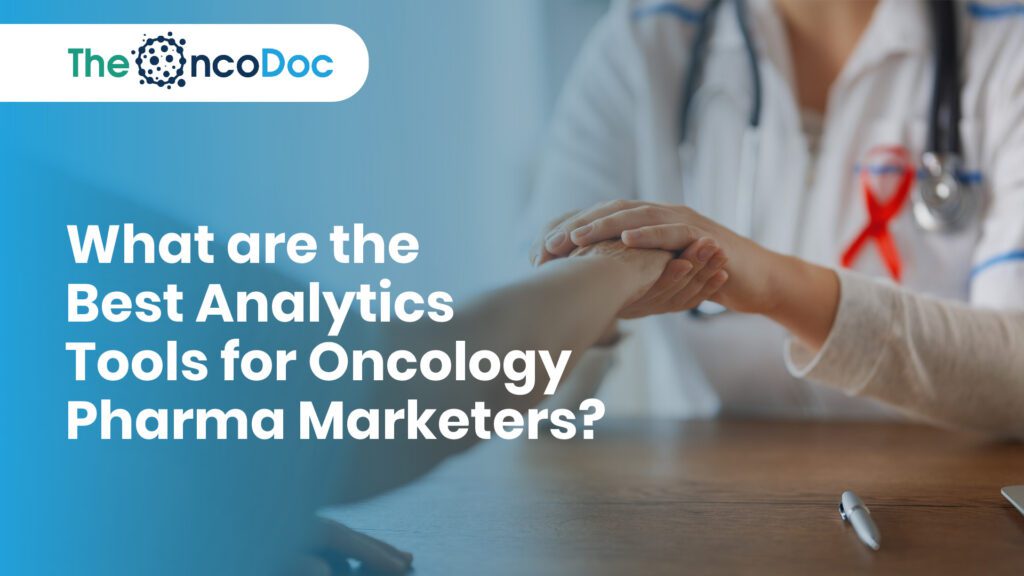Abstract
The oncology pharmaceutical market, characterized by its scientific complexity and stringent regulatory oversight, demands a highly strategic and data-driven approach to marketing. For pharma managers and medical professionals, identifying and leveraging the right analytics tools is no longer a luxury but a necessity for demonstrating value, ensuring compliance, and creating impactful, patient-centric campaigns. This article provides a comprehensive overview of the best analytics tools available to oncology marketers, categorizing them by function—from foundational platforms to specialized healthcare intelligence suites. We explore how these tools enable the measurement of key performance indicators (KPIs) across the entire digital marketing funnel, from engagement and content effectiveness to real-world impact and return on investment (ROI). With a focus on the unique challenges of the oncology field, including ethical data use and complex patient journeys, we offer a strategic roadmap for building a robust analytics stack that drives informed decision-making and ultimately contributes to improved patient outcomes.
Introduction: The Unspoken Language of Data
In the past, the success of an oncology marketing campaign was often measured in terms of sales force reach and prescription volume. Today, the digital revolution has introduced a new, more nuanced language of success—one spoken in data. The modern oncology marketer must be fluent in this language, capable of translating clicks, conversions, and content engagement into actionable insights about patient behavior and HCP needs. This is particularly challenging in oncology, where the patient journey is fragmented, data is sensitive, and the ethical stakes are exceptionally high.
The right analytics tools serve as the Rosetta Stone, decoding this complex digital landscape. They provide the visibility to understand which messages resonate, which channels drive meaningful engagement, and how digital interactions translate into real-world impact. For pharma managers, selecting the optimal analytics stack is a critical strategic decision that can determine a brand’s competitive advantage and its ability to build trust and credibility in a market where both are paramount. This article will guide you through the essential tools, their core functionalities, and how they can be used to navigate the complexities of oncology digital marketing.
Part I: Foundational Analytics Platforms – The Building Blocks
At the core of any effective analytics strategy are a few essential platforms that provide the foundational data infrastructure. These tools are the starting point for collecting and organizing the vast amount of digital data generated by a campaign.
1. Web and Campaign Analytics: The Lens into User Behavior
The most basic, yet crucial, tools for any digital marketer are web and campaign analytics platforms. Google Analytics 4 (GA4) stands out as a powerful and widely adopted free platform. It offers a unified view of user behavior across websites and apps, tracking key events like content downloads, video views, and form submissions. For oncology marketers, GA4 is invaluable for:
- Patient Journey Mapping: By tracking user flow, marketers can understand how patients and caregivers navigate their websites, identifying points of interest or confusion on a complex patient journey.
- Content Performance: GA4 provides insights into which educational resources (e.g., patient guides, infographics on side effect management) are most popular, allowing for content optimization.
- Campaign Attribution: It helps attribute website traffic and conversions to specific digital campaigns, allowing marketers to measure the effectiveness of paid search, social media, and other channels.
2. Social Listening and Engagement Platforms: Capturing the Digital Conversation
In oncology, where patient communities are a vital source of support and information, understanding the digital conversation is critical. Tools like Brandwatch, Sprinklr, and Talkwalker provide sophisticated social listening capabilities. These platforms:
- Monitor Brand and Disease Mentions: They track mentions of a company, its products, or specific oncology topics across social media, forums, and blogs. This helps in understanding sentiment, identifying emerging patient concerns, and addressing misinformation.
- Gauge Community Health: By analyzing sentiment and engagement, marketers can assess the overall health of a patient community and identify influential patient advocates or online opinion leaders.
- Inform Content Strategy: Insights from social listening can inform a content strategy that directly addresses patients’ and HCPs’ most pressing questions and concerns, thereby building credibility and trust.
3. Customer Relationship Management (CRM) Platforms: The Engine of Personalization
For both patient and HCP engagement, CRM platforms are essential for managing and tracking interactions. Veeva CRM and Salesforce Health Cloud are industry leaders, offering features specifically tailored to the healthcare sector. They are used to:
- Manage HCP Relationships: Track engagement with digital content, record interactions from sales representatives, and segment HCPs based on specialty, interest, and prescribing behavior. This allows for highly personalized and compliant communication.
- Patient Support Program (PSP) Management: They serve as the central hub for managing PSPs, tracking patient enrollment, and providing a unified view of a patient’s journey through the program.
- Data Integration: These platforms integrate data from various sources—web analytics, email campaigns, and field interactions—to provide a holistic view of the customer, be it an HCP or a patient in a support program.
Part II: Specialized Analytics for the Oncology Ecosystem
While foundational tools provide the backbone, specialized platforms are what truly differentiate a high-performing oncology marketing team. These tools are designed to tackle the unique data challenges of the life sciences.
1. Healthcare Data and Intelligence Platforms: Bridging Digital and Real-World Evidence
Tools like IQVIA, Definitive Healthcare, and Symphony Health specialize in aggregating and analyzing vast amounts of healthcare data, including anonymized patient records, claims data, and RWE. For oncology marketers, these platforms are indispensable for:
- Market Sizing and Segmentation: Understanding the number of patients with a specific cancer subtype, their geographic distribution, and their treatment pathways.
- Competitive Intelligence: Analyzing competitor promotional activity, market share trends, and HCP prescribing patterns.
- RWE Generation: Using anonymized claims data to generate RWE that demonstrates the real-world impact of a therapy, which is crucial for market access and payer discussions.
2. AI and Machine Learning Platforms: The Future of Insights
Artificial Intelligence is no longer a buzzword; it’s a powerful tool for analyzing complex oncology data. AI platforms, often integrated into other systems, can:
- Predictive Analytics: Forecast patient adherence, identify HCPs who are most likely to adopt a new therapy, and predict potential market shifts.
- Hyper-Personalization: Use AI to analyze RWD and digital behavior to deliver hyper-personalized content at the right time, to the right audience.
- Unstructured Data Analysis: Use Natural Language Processing (NLP) to analyze unstructured data from medical notes or patient forums, uncovering key insights on side effects, treatment experience, and patient sentiment.
3. Content and Performance Management Platforms: The Optimization Engine
These platforms, which can include tools like Google Looker Studio or custom-built dashboards, are essential for bringing all the data together and visualizing it in a meaningful way. They allow for:
- Unified Dashboards: Create a single, easy-to-read dashboard that pulls data from GA4, CRM, and social listening tools, giving pharma managers a holistic view of campaign performance.
- ROI Measurement: Correlate digital marketing metrics (e.g., website traffic from a new campaign) with business outcomes (e.g., new patient enrollments in a PSP or a change in prescribing patterns).
- Compliance Monitoring: Integrate with regulatory platforms to monitor for potential compliance issues, such as off-label mentions in un-moderated content.
Part III: Analytics in Action – Measuring What Matters in Oncology Marketing
In oncology, the metrics for success are as nuanced as the patient journey itself. A robust analytics stack allows marketers to move beyond vanity metrics and measure what truly matters.
1. Engagement and Content Performance:
- Video Completion Rates: Tracking how many viewers watch an educational video to the end indicates its relevance and effectiveness.
- Download Conversions: Measuring the number of times an HCP downloads a clinical trial summary or a patient downloads a disease education guide shows the value of the content.
- Website Navigation Flow: Analyzing how users navigate a website can reveal if they are finding the information they need easily, especially on complex topics like treatment pathways or clinical trials.
2. Patient-Centric Metrics:
- PSP Enrollment and Retention: Measuring how many patients enroll in a support program after a digital touchpoint, and how long they stay engaged, is a key indicator of value.
- Patient Reported Outcomes (PROs): Where ethically and compliantly collected via digital tools, PROs provide invaluable data on how a therapy or a support program is impacting a patient’s quality of life.
- Adherence Rates: Digital tools can track medication adherence, and analytics can help correlate this with exposure to digital content or support programs.
3. Business and ROI Metrics:
- Patient Acquisition Cost (PAC): Calculating the cost to acquire a new patient or to enroll one in a support program through digital channels.
- Marketing Return on Investment (MROI): A more advanced metric that correlates digital campaign spending with business outcomes like prescription volume or market share.
- HCP Prescribing Patterns: Where permissible, correlating a physician’s engagement with a digital campaign to their prescribing behavior can demonstrate the effectiveness of an educational strategy.
Part IV: The Final Piece – Integration, Compliance, and Ethical Use
Even the best tools are useless without a strong strategy for integration, compliance, and ethical use.
- Integration: A modern analytics stack is a connected ecosystem. Data from GA4 should flow into the CRM, and insights from social listening should inform content creation. This requires a dedicated data strategy and a culture of collaboration.
- Compliance: In oncology, data privacy (HIPAA/GDPR) is non-negotiable. All tools must be compliant, and all data must be rigorously anonymized. The marketing team must work closely with legal and regulatory departments to ensure every digital campaign and its analytics are fully compliant.
- Ethical Use: The ultimate goal is to empower patients, not to exploit their data. All analytics should be used to create better, more relevant content that supports the patient journey, not to manipulate them for commercial gain.
Conclusion: The Data-Driven Path to Trust
The future of oncology marketing is intrinsically linked to data and analytics. For pharma managers, the tools discussed in this article are not just instruments for measuring success; they are the architects of trust. By building a robust analytics stack, a company can move beyond a traditional promotional model to one based on education, personalization, and unwavering credibility. This data-driven approach not only optimizes campaign performance and drives business growth but also, more importantly, ensures that every digital interaction serves to empower and support the oncology patient and their healthcare provider, making a tangible difference in their journey toward better health outcomes.
The Oncodoc team is a group of passionate healthcare and marketing professionals dedicated to delivering accurate, engaging, and impactful content. With expertise across medical research, digital strategy, and clinical communication, the team focuses on empowering healthcare professionals and patients alike. Through evidence-based insights and innovative storytelling, Hidoc aims to bridge the gap between medicine and digital engagement, promoting wellness and informed decision-making.



